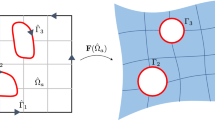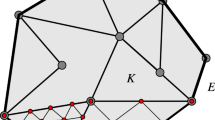Abstract
The Fat Boundary Method is a method of the Fictitious Domain class, which was proposed to solve elliptic problems in complex geometries with non-conforming meshes. It has been designed to recover optimal convergence at any order, despite of the non-conformity of the mesh, and without any change in the discrete Laplace operator on the simple shape domain. We propose here a detailed proof of this high-order convergence, and propose some numerical tests to illustrate the actual behaviour of the method.
Similar content being viewed by others
References
Angot P., Bruneau C.H., Fabrie P.: A penalization method to take into account obstacles in incompressible viscous flows. Numer. Math. 81(4), 497–520 (1999)
Angot P., Ramière I.: Convergence analysis of the Q1-finite element method for elliptic problems with non boundary-fitted meshes. Int. J. Numer. Method Eng. 75(9), 1007–1052 (2008)
Babuška I.: The finite element method with penalty. Math. Comp. 27, 221–228 (1973)
Bertoluzza S.: Interior estimates for the wavelet galerkin method. Numer. Math. 78, 1–20 (1997)
Bertoluzza, S.: The discrete commutator property of approximation spaces. C.R. Acad. Sci. Paris, Série I 329, pp. 1097–1102 (1999)
Bertoluzza, S.: Local boundary estimates for the lagrange multiplier discretization of dirichlet bvp with applications to domain decomposition. Calcolo 43(3) (2006)
Bertoluzza, S., Ismail, M., Maury, B.: The fat boundary method: semi-discrete scheme and some numerical experiments. In: Domain Decomposition Methods in Science and Engineering. Lect. Notes Comput. Sci. Eng., vol. 40, pp. 513–520. Springer, Berlin (2005)
Brezis H.: Analyse fonctionnelle, Théorie et applications. Masson, Paris (1983)
Brezzi F., Fortin M.: Mixed and Hybrid Finite Element Methods, Springer Series in Computational Mathematics, vol. 15. Springer, New York (1991)
Ciarlet P.: The Finite Element Method for Elliptic Problems. North-Holland, Amsterdam (1978)
Codina R., Houzeaux G., Coppola-Owen H., Baiges J.: The fixed-mesh ALE approach for the numerical approximation of flows in moving domains. J. Comput. Phys. 228, 1591–1611 (2008)
Feng Z., Michaelides E.: Proteus: a direct forcing method in the simulations of particulate flows. J. Comput. Phys. 202(1), 20–51 (2005)
Girault V., Glowinski R.: Error analysis of a fictitious domain method applied to a Dirichlet problem. Jpn J. Ind. Appl. Math. 12(3), 487–514 (1995)
Griffith B., Peskin C.: On the order of accuracy of the immersed boundary method: higher order convergence rates for sufficiently smooth problems. J. Comput. Phys. 208(1), 75–105 (2005)
Grisvard P.: Elliptic Problems in Nonsmooth Domains. Pitman, London (1985)
Haslinger J., Renard Y.: A new fictitious domain approach inspired by the extended finite element method. SIAM J. Numer. Anal. 47(2), 1474–1499 (2009)
Hecht, F., Pironneau, O.: A Finite Element Software for PDEs : FreeFEM++ (http://www.freefem.org/)
Lenoir M.: Optimal isoparametric finite elements and error estimates for domains involving curved boundaries. SIAM J. Numer. Anal. 23(3), 1–20 (1986)
LeVeque R., Li Z.: The immersed interface method for elliptic equations with discontinuous coefficients and singular sources. SIAM J. Numer. Anal. 31, 1019–1044 (1994)
Luo X., Maxey M., Karniadakis G.: Smoothed profile method for particulate flows: error analysis and simulations. J. Comput. Phys. 228, 1750–1769 (2008)
Maury B.: A fat boundary method for the Poisson problem in a domain with holes. J. Sci. Comput. 16(3), 319–339 (2001)
Maury B.: Numerical analysis of a finite element volume penalty method. SIAM J. Numer. Anal. 47(2), 1126–1148 (2009)
Nitsche J., Schatz A.: Interior estimates for Ritz–Galerkin methods. Math. Comp. 28, 937–958 (1974)
Oevermann M., Klein R.: A Cartesian grid finite volume method for elliptic equations with variable coefficients and embedded interfaces. J. Comput. Phys. 219(2), 749–769 (2006)
Pan T.W., Glowinski R.: Direct simulation of the motion of neutrally buoyant circular cylinders in plane Poiseuille flow. J. Comput. Phys. 181(1), 260–279 (2002)
Pedercin M., Patera A.T., Cruz M.E.: Variational bound finite element methods for three-dimensional creeping porous media and sedimentation flows. Int. J. Numer. Methods Fluids 26(2), 145–175 (1998)
Peskin C.: Flow patterns around heart valves: a numerical method. J. Comput. Phys. 10, 252 (1972)
Peskin, C.: The immersed boundary method. Acta Numer. pp. 479–517 (2002)
Prosperetti A., Og̃uz H.: Physalis: a new o(N) method for the numerical simulation of disperse systems: potential flow of spheres. J. Comput. Phys. 167, 196–216 (2001)
Russel D., Wang Z.: A cartesian grid method for modeling multiple moving objects in 2d incompressible viscous flow. J. Comput. Phys. 191, 177–205 (2003)
Saul’ev V.: Solution of certain boundary-value problems on high-speed computers by the fictitious-domain method. Sibirsk. Mat. Z̆. 4, 912–925 (1963)
Serbin, L.: A computational investigation of least squares and other projection methods for the approximate solution of boundary value problems. Ph.D. thesis, Cornell University, Ithaca, N. Y. (1971)
Vos P., van Loon R., Sherwin S.: A comparison of fictitious domain methods appropriate for spectral/hp element discretisations. Comput. Methods Appl. Mech. Eng. 197(25–28), 2275–2289 (2008)
Zhang Z., Prosperetti A.: A second-order method for three-dimensional particle simulation. J. Comput. Phys. 210(1), 292–324 (2005)
Author information
Authors and Affiliations
Corresponding author
Rights and permissions
About this article
Cite this article
Bertoluzza, S., Ismail, M. & Maury, B. Analysis of the fully discrete fat boundary method. Numer. Math. 118, 49–77 (2011). https://doi.org/10.1007/s00211-010-0317-4
Received:
Revised:
Published:
Issue Date:
DOI: https://doi.org/10.1007/s00211-010-0317-4




